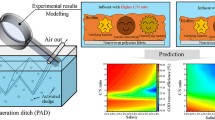Abstract
A next generation septic tank media filter to replace or enhance the current on-site wastewater treatment drainfields was proposed in this study. Unit operation with known treatment efficiencies, flow pattern identification, and system dynamics modeling was cohesively concatenated in order to prove the concept of a newly developed media filter. A multicompartmental model addressing system dynamics and feedbacks based on our assumed microbiological processes accounting for aerobic, anoxic, and anaerobic conditions in the media filter was constructed and calibrated with the aid of in situ measurements and the understanding of the flow patterns. Such a calibrated system dynamics model was then applied for a sensitivity analysis under changing inflow conditions based on the rates of nitrification and denitrification characterized through the field-scale testing. This advancement may contribute to design such a drainfield media filter in household septic tank systems in the future.






Similar content being viewed by others
References
Abbott MD, Stanley RS (1999) Modeling groundwater recharge and flow in an upland fracture bedrock aquifer. Syst Dynam Rev 15:163–184
Beran B, Kargi F (2005) A dynamic mathematical model for wastewater stabilization ponds. Ecol Modell 181:39–57
Chang NB, Xuan Z, Daranpob A, Wanielista M (2010) A subsurface upflow wetland system for removal of nutrients and pathogens in on-site wastewater treatment plants. Environ Eng Sci 28(1):11–24
Chang NB, Hossain F, Wanielista M (2010) Use of filter media for nutrient removal in natural systems and built environments (I): previous trends and perspectives. Environ Eng Sci 27(9):689–706
Chang NB, Wanielista M, Daranpob A (2010) Use of filter media for nutrient removal in natural systems and built environments (II): design challenges and application potentials. Environ Eng Sci 27(9):707–720
Chang NB, Wanielista M, Daranpob A, Xuan Z, Hossian F (2010) New performance-based passive septic tank underground drainfield for nutrient and pathogen removal using sorption media. Environ Eng Sci 27(6):469–482
Chang NB, Wanielista M, Daranpob A, Hossian F, Xuan Z, Miao J, Liu S, Marimon Z, Debusk S (2011) On-site sewage treatment and disposal systems evaluation for nutrient removal (Final report). Florida Department of Environmental Protection, Tallahassee, Florida
Deaton ML, Winebrake JJ (2000) Dynamic modeling of environmental systems. Springer, New York
Dyson B, Chang NB (2005) Forecasting of solid waste generation in an urban region by system dynamics modeling. Waste Manage 25(7):669–679
Elmahdi A, Malano H, Etchells T (2007) Using system dynamics to model water-reallocation. Environmentalist 27(1):3–12
Ford A (1999) Modeling the environment. Island Press, Washington, DC
Gao N, Armatas NG, Shanley JB, Kamman NC, Miller EK, Keeler GJ, Scherbatskoy T, Holsen TM, Young T, McIlroy L, Drake S, Olsen B, Cady C (2006) Mass balance assessment for mercury in Lake Champlain. Environ Sci Technol 40(1):82–89
Guo HC, Liu L, Huang GH, Fuller GA, Zou R, Yin YY (2001) A system dynamics approach for regional environmental planning and management: a study for Lake Erhai Basin. J Environ Manag 61:93–111
Hoover M (2002) Performance standards for wastewater pretreatment, Northeast on-site wastewater short course and equipment exhibition. Oral Presentation, Newport, pp 25–26
Hossain F, Chang NB, Wanielista M, Xuan Z, Daranpob A (2010) Nitrification and denitrification effect in a passive on-site wastewater treatment system with a recirculation filtration tank. Water Qual Expo Health 2:31–46
Kabi Das B, Bandyopadhyay M, Mohapatra PKJ (1997) System dynamics modeling of biological reactors for waste water treatment. J Environ Syst 25(3):213–240
Kadlec RH, Knight R (1996) Treatment wetlands. CRC Press, Boca Raton
Mayo AW, Mutamba J (2005) Nitrogen transformation in horizontal subsurface flow constructed wetland I: model development. Phys Chem Earth 30:658–667
Pan Y, Raynal DJ (1995) Decomposing tree annual volume increments and constructing a system dynamic model of tree growth. Ecol Modell 82(3):299–312
Smith DP, Otis R, Flint M (2008) Florida passive nitrogen removal study (Final report). Florida Department of Health, Tallahassee
US Environmental Protection Agency (USEPA) (2002) Chapter1: Background and use of onsite wastewater treatment systems, in onsite wastewater treatment systems manual EPA/625/R-00/008, Office of research and development. Washington, DC, USA
Vezjak M, Savsek T, Stuhler EA (1998) System dynamics of eutrophication processes in lakes. Euro J Operation Res 109:442–451
Vizayakumar K, Mohapatra PKJ (1993) Modeling and simulation of environmental impacts of a coalfield: system dynamic approach. J Environ Manage 42:59–73
Wanielista M, Chang NB, Makkeasorn A (2008) Provisional patent: “Passive underground drainfield for septic tank nutrient removal using special functionalized green filtration media. Atty. Docket No: UCF-663. US Patent filed under review
Wood TS, Shelley ML (1999) A dynamic model of bioavailability of metals in constructed wetland sediments. Ecol Eng 12:231–252
Xuan Z, Chang NB, Makkeasorn A, Wanielista M (2009) Initial test of a subsurface constructed wetland with green sorption media for nutrient removal in on-site wastewater treatment systems. Water Qual Expo Health 1(3–4):159–169
Xuan Z, Chang NB, Daranpob A, Wanielista M (2010) Modeling the subsurface upflow wetland (SUW) system for wastewater effluent treatment. Environ Eng Sci 27(10):879–888
Xuan Z, Chang NB, Wanielista M, Hossain F (2010) Laboratory-scale characterization of the green sorption medium for wastewater treatment to improve nutrient removal. Environ Eng Sci 27(4):301–312
Acknowledgments
The authors are grateful for the financial support provided by an Urban Nonpoint Source Research Grant from the Bureau of Watershed Restoration, Florida Department of Environmental Protection.
Author information
Authors and Affiliations
Corresponding author
Rights and permissions
About this article
Cite this article
Xuan, Z., Chang, NB. & Wanielista, M. Modeling the system dynamics for nutrient removal in an innovative septic tank media filter. Bioprocess Biosyst Eng 35, 545–552 (2012). https://doi.org/10.1007/s00449-011-0627-7
Received:
Accepted:
Published:
Issue Date:
DOI: https://doi.org/10.1007/s00449-011-0627-7




